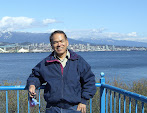 Dear Dr Tomas Tarigan,
Dear Dr Tomas Tarigan,There are 2 universities in the Greater Vancouver area, University of British Columbia (UBC) and Simon Fraser University (SFU). A few years back I took a very good friend of mine Mintayu br Sembiring visiting from Jakarta (bottom photo), I am sure that you have met her before, to tour SFU main campus in Burnaby, a suburb of Vancouver.
SFU is located on top of Burnaby Mountain, about 45 minutes drive from where I live. It is the highest point in Burnaby, 1100 feet above sea level and has a commanding view of the surrounding areas, including the Fraser River and Vancouver City skyline in the distance. It is the best and most expensive property location reserved for higher learning to keep students inspired and motivated. SFU was designed by Arthur Erickson a UBC architecture professor and his partner Geoffrey Massey with design for growth in mind. The growth was to be incremental and continuous, and to date is still growing and expanding depending on future programs need. SFU was named after a British explorer, Simon Fraser that could be called the founding father of British Columbia, who explored land west of Rocky Mountains and the Fraser River from 1805-1818.
 The SFU was opened in September 9, 1965 with 2500 students. Now there are about 25 000 students across 3 campuses: Burnaby as the main campus and the extensions in Vancouver and Surrey. Simon Fraser University offered students in undergraduate and post graduate studies in 6 faculties:
The SFU was opened in September 9, 1965 with 2500 students. Now there are about 25 000 students across 3 campuses: Burnaby as the main campus and the extensions in Vancouver and Surrey. Simon Fraser University offered students in undergraduate and post graduate studies in 6 faculties:Faculty of Applied Sciences with 5 programs.
Faculty of Arts&Social Sciences: 27 programs.
Faculty of Business Administration: 9.
Faculty of Education: 11 programs.
Faculty of Health Sciences: 2 programs.
Faculty of Science with 11 programs ranging from Biological Sciences to Statistic&Actuarial Sciences.
Counting the specialized and minor programs, there are close to 100 programs in total from the 6 faculties with the 25 000 students enrolled in.
As you might have noticed that Faculty of Medicine, Faculty of Law, Faculty of Dentistry are not offered at SFU. Nor programs in Civil, Electrical and Mechanical Engineering from Faculty of Applied Sciences among other things not offered at SFU. What you can not get at SFU, you probably can get it at University of British Columbia, because the 2 universities are complementing each other. There are close to 4000 students now are doing post graduate studies from various programs in the 6 faculties. A High School graduate with an average of 75% will meet most of the admission requirements to undergraduate programs at SFU.
SFU also has a program in International Development partnership, to assist developing countries in strengthening their knowledge infrastructure, by offering graduate studies to their professionals in the fields of research and development. I have met a few of students in that respect: one Indonesian lecturer from University in Menado doing post graduate studies leading to his MSc in Statistics, another Indonesian lecturer from University in Medan doing his MSc in Resource Management, one student from China doing his MSc and continue to do his PhD in Mathematics and one student from Peru doing his MSc in Physics.
The library is one of the best looking architecture at SFU, and matched with good reference books that are available there. It is an active learning place in itself. Every summer SFU is conducting a lecture series by inviting prominent scholars giving lecture that is open to general public. The prominent Scientist and Conservationist Dr Birute Galdikas an expert in primatologist giving such lecture a few times in the past. She has been over 25 years involved in research and preservation of endangered "orang utan" in Tanjung Puting National Park, Kalimantan, Indonesia.
SFU also has a very good sport programs available to students ranging from basketball, cross-country, football, golf, soccer, softball, swimming, track&field, volley ball and wrestling. A pity that they don't have badminton, my favourite. But they do have regular competition with other universities across Canada in many of the sports above, which organized by CIS (Canadian Inter universities Sport) and NAIA (National Association Intercollegiate Athletics). It is important to have a sound body to have a sound mind by exercising regularly.
(Top photo): Academic Quadrangle, contains major lecture halls, classrooms, offices, corridors and large outdoor gardens. Convocation takes place twice a year one in June and another in October. The parades of Graduates begin at the AQ gardens.
(Bottom photo): Convocation Mall, has a glass roof that covers the entire area. It is used for graduation ceremony, rain snow or shine.





